What is a lipoma?
Lipoma is a benign (noncancerous) tumor made of fatty tissue [1]. It appears under the skin or deep in the body in 1-2% of people, mainly in middle-aged adults [1,6].
Symptoms and Signs
Subcutaneous lipoma occurs under the skin as a lump, which can be single or multiple and is usually 0.4-6 inch (1-15 cm) in size, dome-shaped, with normal overlying skin, soft (rarely hard), smooth, movable and painless [1,3,4]. A lipoma that contains many blood vessels (angiolipoma) or presses upon a nerve can be tender or painful [7,9].
Lipomas tend to grow slowly over the years until they reach a certain size [2].
Common locations include the neck, shoulders, arms, armpits, buttocks and thighs.
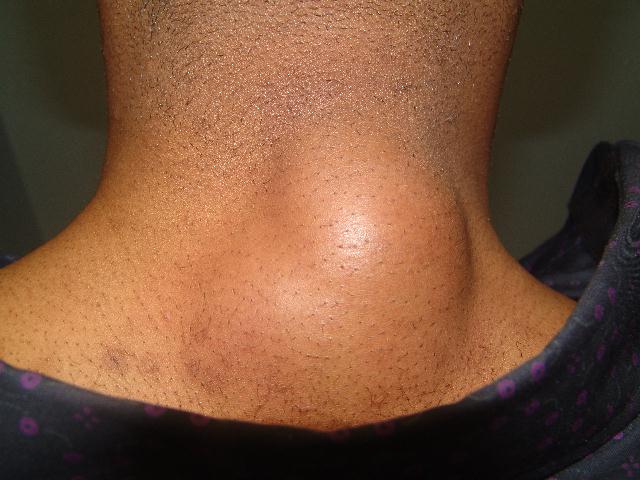
Picture 1. A big lipoma at the back of the neck
(source: Dr. Ghorayeb, MD, Ghorayeb.com, CC license)
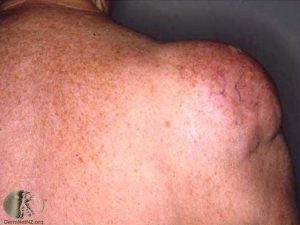
Picture 2. A lipoma on the shoulder
(source: DermNetNZ, CC license)
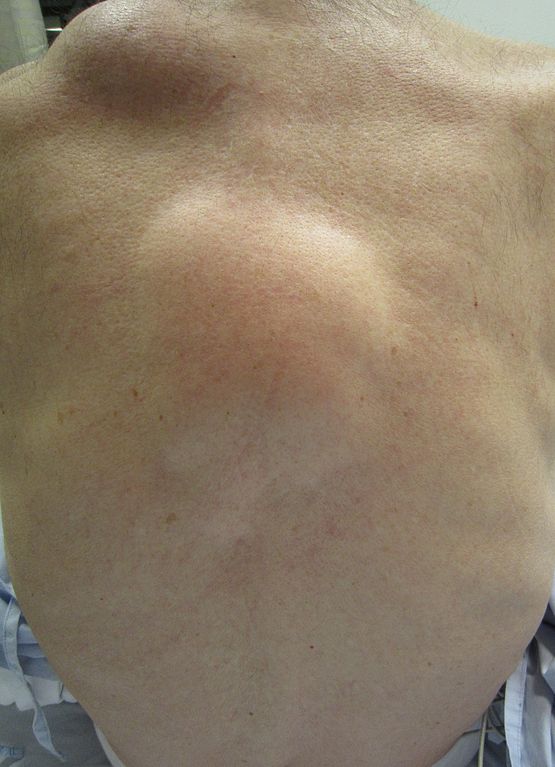
Picture 3. Two large lipomas on the upper back (source: Wikimedia, CC license)
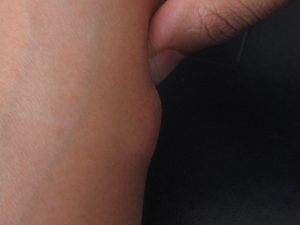
Picture 4. A lipoma on the arm
(source: Wikimedia, CC license)
Intramuscular lipoma, for example, in the thigh or calf muscles, can cause localized pain and swelling of the limb.
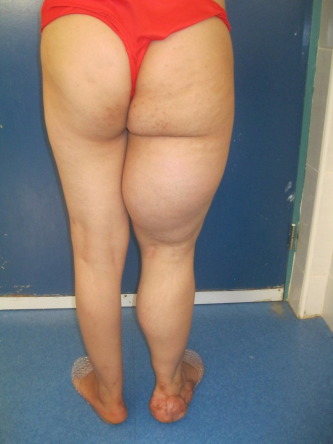
Picture 5. A lipoma in the muscles of the right thigh (source: ScienceDirect, CC license)
Episacral lipoma occurs as a result of a tear in the muscle fascia in the lower back. It appears as a small tender nodule above the pelvis, 2-3 inches to the right or left from the spine [11]. The pain can radiate down the back of the leg on the same side.
Gastrointestinal lipomas in the esophagus, stomach, the small or large intestine can bleed and obstruct the intestine resulting in blood in the stool, severe abdominal pain, vomiting or jaundice [1].
Rarely, lipomas develop in other internal organs, such as heart, brain, spinal cord, thyroid or uterus, in the joints, nose, mouth, vulva, etc. and cause related symptoms [1].
Parosteal lipoma is a rare, usually painless, lipoma associated with the periosteum – the membrane that covers the bone [12]. It occurs mainly in the thigh bone (femur) and arm bones (humerus, radius), but also in the skull, rib cage, hand, foot or other bones.
Intraosseous lipoma is a rare painful or painless tumor in the medullar cavity of the long bones in an arm or leg [13].
Causes and Risk Factors
The cause of lipoma is usually not known. The risk factors may include [1,5]:
- Family history of lipoma
- Injury
- Liposuction
- Sedentary lifestyle
Causes of Multiple Lipomas
Multiple lipomas can occur incidentally or as part of other (rare) conditions [7]:
- Adiposis dolorosa or Dercum’s disease (painful lipomas)
- Benign symmetric lipomatosis or Madelung’s disease (mainly in chronic alcoholics)
- Familial multiple lipomatosis (in more than one family member)
- Familial adenomatous polyposis or Gardner’s syndrome (inherited; involves subcutaneous lipomas, epidermoid cysts and colorectal polyps)
Diagnosis
A doctor can recognize a lipoma by a physical examination.
Investigations are needed when the diagnosis is not clear or when surgery is considered. Ultrasound and computed tomography (CT) can both reveal lipomas, but magnetic resonance imaging (MRI) can provide most information [8,10]. An MR image alone can sometimes help to distinguish between a lipoma and liposarcoma (cancer) [1,6].
Taking a piece of a lipoma by needle aspiration (a biopsy) and histological examination under the microscope may be needed for final diagnosis.
Chart 1. Conditions Similar to Lipoma |
|
|
|
Chart 1 references: 6,7
Lipoma Removal
Lipomas are usually treated only when they are painful or rapidly growing or for cosmetic reasons.
Surgical Excision
Surgical excision refers to complete lipoma removal including the fatty mass and the surrounding capsule.
Video 1. Surgical excision of a lipoma
Liposuction
Liposuction refers to removal of the fatty tissue through a small incision via a tube connected to a negative pressure. This method is intended to treat lipomas on the face, multiple or big lipomas because it leaves minimal scarring.
Liposuction does not remove the lipoma’s capsule, which may result in lipoma recurrence. After liposuction, a surgeon may or may not excise the remaining fat and capsule [15].
Nonsurgical Treatment
Nonsurgical methods of lipoma removal include:
- Steroid injections, which can result in a lipoma shrinkage in 3-4 weeks [7]
- Fat dissolution (lipolysis) with phosphatidylcholine and deoxycholate [9]
- Endoscopic removal of the lipomas in the gastrointestinal tract [5]
There is a review of various methods of lipoma removal, including excision by laser, liposuction, ultrasound, etc. on Clinicaldermatology.eu.
Massage, cupping and acupuncture do not likely result in pain relief or lipoma disappearance.
Natural Treatment at Home
There seems to be no reliable evidence about the effectiveness of natural herbal or other remedies in the treatment of lipoma, including castor, flaxseed, neem, sage or tea tree oil, chickweed, flour and honey, propolis, beeswax, turmeric, egg yolk and salt, or apple cider vinegar.
Prognosis
Lipomas do not likely heal on their own but, in most cases, also do not cause severe problems. It is not known if lipoma can develop into cancer known as liposarcoma [1].
A lipoma that has been completely removed together with its capsule is usually permanently cured, while lipomas treated by other methods (liposuction, lipolysis) can recur [5].
Prevention
There is no known diet or other measures to prevent lipoma.


Is there any capsule, syrup or tablet that can be used to shrink or destroy lipoma completely.
Does one see a dermatologist for limomas?